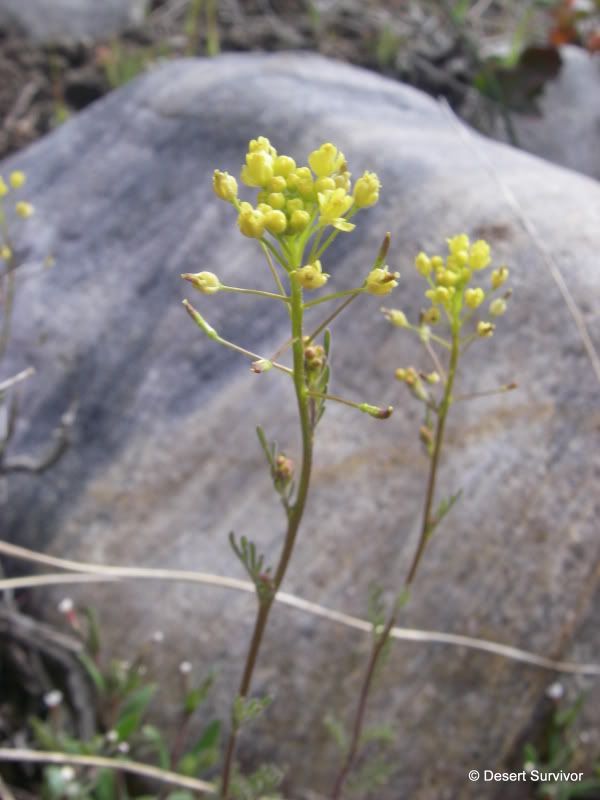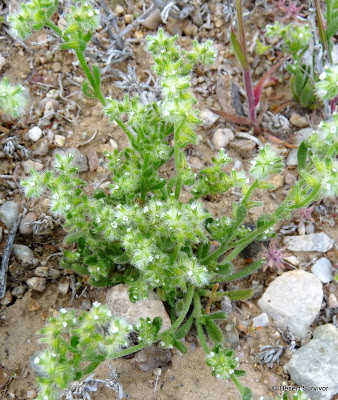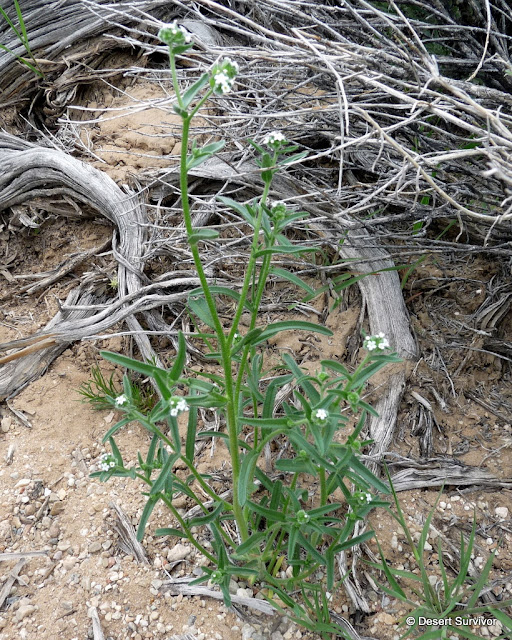The Astragalus are a little intimidating because there are so many, but this one only took half an hour to figure out. Hopefully that means I will remember it better! It's Beckwith's milkvetch (Astragalus beckwithii var. purpureus). Identifying characteristics are glabrous (smooth) leaves (for the most part), and flowers in a loose head. This variety is found in Utah and Nevada on gravelly soils.
Later a freckled, curved pod will appear.
For a little more info about Beckwith's Milkvetch from the USDA Plants Database, click here.
Tuesday, May 31, 2011
Monday, May 30, 2011
Nebraska Sedge - Carex nebrascensis
I guess it's time to dive into a big, new family: the Sedge Family (Cyperaceae). We have over 50 species in it, and the words used in the key are a whole new language to me! This sedge is very common, Nebraska sedge (Carex nebrascensis), so it's not too hard to learn.
It grows in many western states and two western provinces. It's a perennial cool season sedge, growing up to 36 inches high. It is found at a variety of elevations in moist places.
For much more info about Nebraska sedge, click here.
It grows in many western states and two western provinces. It's a perennial cool season sedge, growing up to 36 inches high. It is found at a variety of elevations in moist places.
For much more info about Nebraska sedge, click here.
Sunday, May 29, 2011
Spotted Stickseed - Hackelia patens
This pretty flower is a member of the Borage Family (Boraginaceae) and is called spotted stickseed (Hackelia patens). It grows in several western U.S. states in openings in sagebrush at a wide variety of elevations.
The plant is tall, up to about two feet tall, with the white flowers with blue tinge occurring in clusters.
For more info on spotted stickseed, click here.
The plant is tall, up to about two feet tall, with the white flowers with blue tinge occurring in clusters.
For more info on spotted stickseed, click here.
Saturday, May 28, 2011
Water Birch - Betula occidentalis
This tree that likes to grow right next to streams is water birch (Betula occidentalis), which is in the Birch Family (Betulaceae), the only member of that family in this area. It grows in western North America.
Leaves are bright green and heart-shaped, with a dentate margin. Catkins grow along the twigs.
The bark for water birch is red with white spots. Older bark gets shaggy and starts peeling off.
For more info about water birch, see this USU webpage.
Leaves are bright green and heart-shaped, with a dentate margin. Catkins grow along the twigs.
The bark for water birch is red with white spots. Older bark gets shaggy and starts peeling off.
For more info about water birch, see this USU webpage.
Wednesday, May 25, 2011
Field Pepperweed-Lepidium campestre

This non-native weed from Europe is field peppeweed (Lepidium campestre), one of the many members of the Mustard Family (Brassicaceae) that has made its way across the ocean. It now grows in much of North America in disturbed areas.

Flowers are white with four petals.

The leaves are an important distinguishing feature--they clasp the stem.

For more info on field pepperweed, click here.
Sunday, May 22, 2011
Cushion Buckwheat - Eriogonum ovalifolium
When I was uploading these photos I found I had some from last year, like the one above. It's been difficult finding new flowers for this blog, but what I have found is that I have some photos of species that I haven't yet identified, some due to time, some due to difficulty.
Nevertheless, this little white puffball has now found its way onto this blog. It's cushion buckwheat (Eriogonum ovalifolium), a member of the Buckwheat Family (Polygonaceae).
The buds are quite pink, then the flowers are usually white, but get pinker with age. The leaves are distinctive, with their wavy pattern.
The species name ovalifolium is Latin for oval-shaped. Cushion buckwheat grows in western North America and has about 11 varieties.
For more information about cushion buckwheat, click here.
Nevertheless, this little white puffball has now found its way onto this blog. It's cushion buckwheat (Eriogonum ovalifolium), a member of the Buckwheat Family (Polygonaceae).
The buds are quite pink, then the flowers are usually white, but get pinker with age. The leaves are distinctive, with their wavy pattern.
The species name ovalifolium is Latin for oval-shaped. Cushion buckwheat grows in western North America and has about 11 varieties.
For more information about cushion buckwheat, click here.
Tuesday, May 17, 2011
Tall Tumblemustard - Sisymbrium altissimum
This four-petaled flower in the Mustard Family (Brassicaceae) is attractive right now, but unfortunately it's non-native to North America, where it is widespread. This is tall tumblemustard (Sisymbrium altissimum). Over the summer it dries out and eventually strong winds can snap the plant down and blow it around, further spreading seeds. Of historical interest, it is thought that early railroads helped distribute this species.
It can grow 3-5 feet high, and leaves are deeply divided at the base.
For more info on tall tumblemustard, click here.
It can grow 3-5 feet high, and leaves are deeply divided at the base.
For more info on tall tumblemustard, click here.
Monday, May 16, 2011
Bearded Cryptantha - Cryptantha barbigera
This low elevation cryptantha that is extremely hairy is called bearded cryptantha (Cryptantha barbigera). It grows in the southwestern U.S. and blooms in May in our area. It's up to about a foot high, and with the tiny white flowers can easily be overlooked.
For more info on bearded cryptantha, click here.
For more info on bearded cryptantha, click here.
Saturday, May 14, 2011
Eyed Gilia - Gilia ophthalmoides
 This inconspicuous flower growing on gravelly areas is part of the Phlox Family (Polemoniaceae). It's eyed gilia (Gilia ophthalmoides), and grows in the western U.S. The corolla (yellow and lavender parts) extends far from the calyx (red-striped part that covers the bottom of the corolla).
This inconspicuous flower growing on gravelly areas is part of the Phlox Family (Polemoniaceae). It's eyed gilia (Gilia ophthalmoides), and grows in the western U.S. The corolla (yellow and lavender parts) extends far from the calyx (red-striped part that covers the bottom of the corolla).Like most gilia species, eyed gilia has a rosette of basal leaves. For this species, the leaves and stem are very hairy, with some hairs appearing almost like cobwebs.
For more info about eyed gilia, click here.
Sunday, May 8, 2011
Narrowstem Cryptantha - Cryptantha gracilis
I'm seeing cryptantha all over the place, mostly Cryptantha pterocaya, Cryptantha flavoculata, Cryptantha confertiflora, and Cryptantha circumscissa, all of which I've blogged about. This one is different, and I think it's Narrowstem Cryptantha (Cryptantha gracilis). The key examines the nutlets in great detail. The nutlets come out after the flowers, which make that tricky. If I don't have this identification right, please leave a note in the comments.
Narrowstem cryptantha grows on rocky slopes from 5500 to 6500 feet in our area in May and June. It's found throughout western U.S.
For more info on Narrowstem cryptantha, click here.
Narrowstem cryptantha grows on rocky slopes from 5500 to 6500 feet in our area in May and June. It's found throughout western U.S.
For more info on Narrowstem cryptantha, click here.
Monday, May 2, 2011
Western Tansymustard - Descurainia pinnata

This nonnative mustard, western tansymustard (Descurainia pinnata) likes disturbed areas at all elevations below 10,200 feet. It grows throughout North America.
Click here to get to the USDA Plants Database page for western tansymustard, with links at the bottom of it.
Sunday, May 1, 2011
Longbeak Streptanthella - Streptanthella longirostris
This neat looking plant in the Mustard Family (Brassicaceae) (note the four petals) is longbeak streptanthella (Streptanthella longirostris). The genus name means twisted flower in Greek, while the species name means long-beaked. The seeds become long and pointy.
This flower has a close cousin, Streptanthus, also found in the area, but the leaves for it are wider and clasp the stem. Below you can see the narrow leaves of Streptanthella.

For more info on Longbeak Streptanthella, click here.
Subscribe to:
Posts (Atom)



























